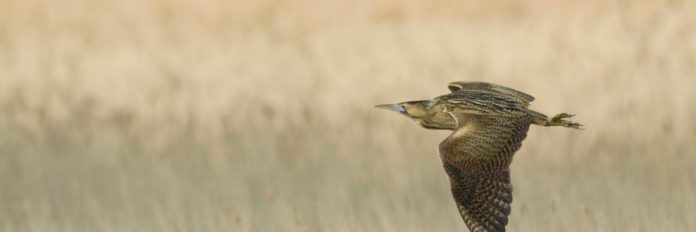Britain’s loudest bird, once extinct in the UK, has enjoyed its best year since records began, according to a new survey. The bittern – a kind of heron – is doing well following intensive conservation efforts.
Bitterns are highly secretive wetland birds and live most of their time within dense stands of reed, making them very difficult to survey. However, scientists count bitterns by listening for the male’s foghorn-like booming call, and this year numbers increased to at least 164, recorded at 71 sites. That compares to 162 at 78 sites in 2016, and is a positive sign that bitterns are back from the brink and thriving.
The annual monitoring, organised by the RSPB, found that the number of booming males in Somerset increased by two, from 47 to 49 boomers, although there was a slight drop this year in the core areas in eastern England; Suffolk Coast, Norfolk Broads and The Fens. Booming was also reported from three new sites, and there was an increase in Wales this year.
Bitterns were considered extinct as a breeding species in the UK by the 1870s. Following recolonisation early in the 20th Century, numbers of bitterns increased to a peak of about 80 booming males in the 1950s, but then fell to fewer than 20 in the 1990s, with similar declines witnessed in many other countries in Western Europe. By 1997, there were only eleven booming male bitterns in the UK; these were mainly within Norfolk and Suffolk, with a small outlying population at Leighton Moss, in Lancashire.
Simon Wotton, Senior Conservation Scientist at the RSPB, said: “In the late 1990s, the bittern was heading towards extinction once again in the UK. But, thanks to conservation efforts to restore and create its preferred habitat of wet reedbed, the bittern was saved and we’re delighted to see another record year for this amazing bird.”
A combination of legal protection combined with funding through two EU LIFE projects have been vital in aiding the recovery of bittern. It is important that the levels of protection afforded to species such as bittern are maintained or ideally enhanced following our exit from the EU.
Almost half of Britain’s breeding bittern population occur within Special Protection Areas (SPAs), however more than half of our still vulnerable population occurs at sites which to date have no protection including many of those sites created through conservation projects. To ensure the Britain’s bittern population continues to recover, there is a need to continue the progress made to complete a robust and well managed network of protected sites.







